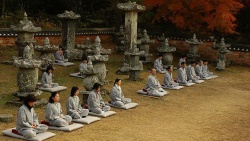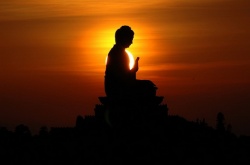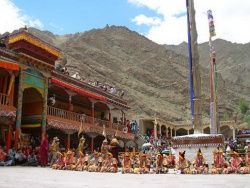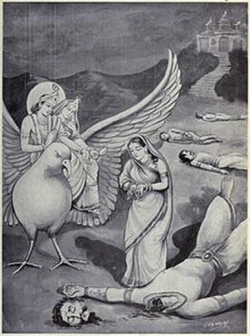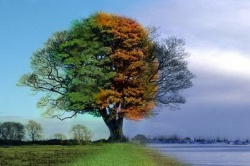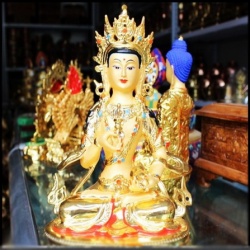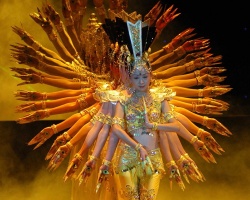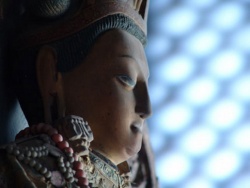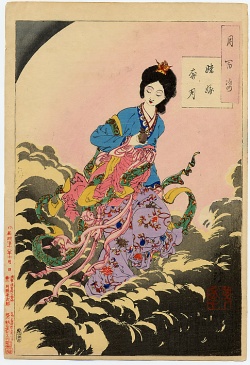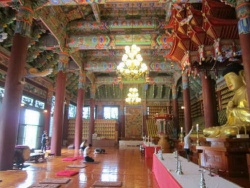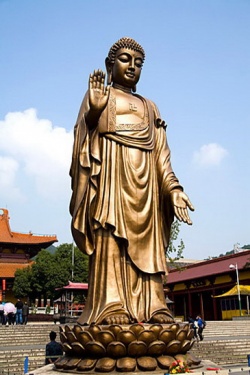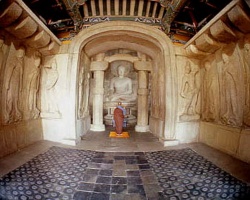Ngöndro
Click here to see other articles relating to word Ngöndro
Ngöndro (Wyl. sngon ‘gro) — the preliminary practice or ‘foundation practices of Vajrayana Buddhism.
The ngöndro practices are profound and powerful means for effecting a deep purification and transformation, at every level of our being.
Not only do they prepare the practitioner for the profound path of Vajrayana and teachings of Dzogchen, but they also lead him or her gradually towards the experience of enlightenment.
Dilgo Khyentse Rinpoche said:
- When we take our first steps on the Path, we are not yet capable of helping others. To accomplish the good of others, we must first perfect ourselves, by purifying and transforming our minds.
This is the aim of what we call the preliminary practices, which establish the foundations of all spiritual progress.
You may feel like dispensing with these foundations in order to practice teachings that you think are more profound, but if you do so, you are building a palace on the surface of a frozen lake.[1]
Etymology
In Tibetan, ngön means ‘before’, whilst dro means ‘to go’. So ngöndro is usually translated as ‘preliminary practices’, or ‘foundation practices’.
Stages of the Practice
The Outer Preliminaries
The foundation practices begin with a series of life-changing contemplations—the outer preliminaries—embracing:
- the uniqueness and opportunity of human life;
- the ever-presence and deeper meaning of impermanence and death;
- the infallibility of the cause and effect of our actions, karma; and
- the repetitive cycle of frustration and suffering that is samsara.
These contemplations are known as the "four thoughts".
The Inner Preliminaries
These reflections inspire a strong sense of renunciation, an urgent desire to emerge from samsara and follow the path to liberation, which forms the foundation for the specific practices—the inner preliminaries—of:
- taking refuge in the Buddha as the guide, the truth of his teaching (the Dharma) as the path, and the example of his practitioners (the Sangha) as companions on the path, so awakening a confidence and trust in our own inner buddha nature;
- giving birth to love and compassion—bodhichitta, the heart of the enlightened mind—and training the mind to work with ourselves, with others, and with the difficulties of life;
- removing obscurations of all kinds through the purification and healing practice of meditating on Vajrasattva and reciting his mantra;
- accumulating merit and wisdom by developing universal generosity and creating auspicious circumstances, through the mandala offering;
[[Image:LNNRefuge.jpg|thumb|250|Field of Merit from the Longchen Nyingtik Ngöndro)]
- finally, in the practice of guru yoga, which is the most crucial, moving and powerful practice of all, we unite our mind with the wisdom mind of all the buddhas and so awaken the wisdom of realization.
Purifying the obscurations
It is sometimes said that
- prostrations remove the obscurations associated with the body,
- recitation of the hundred syllable mantra removes obscurations associated with speech,
- mandala offering removes obscurations associated with mind, and
- guru yoga removes the obscurations of all three: body, speech and mind.
Versions of the Ngöndro
The two principal ngöndros that the Rigpa sangha practise are:
- the Brief Dudjom Tersar Ngöndro, and
- the Longchen Nyingtik Ngöndro.
External Links
Ngöndro (Tib., Wylie: sngon 'gro, pronounced "nundro"; known in Sanskrit as pūrvaka) refers to the preliminary, preparatory or foundational 'practices' or 'disciplines' (Sanskrit: sadhana) common to all four schools of Tibetan Buddhism and also to Bön.
The Tibetan term ngöndro literally denotes meanings in the range of "something that goes before, something which precedes."
The preliminary practices establish the foundation for the more advanced and rarefied Vajrayana sadhana which are held to engender realization and the embodiment of enlightenment.
Nevertheless, Vajrayana masters are careful to point out that "foundational" does not mean "lesser", that the practice of Ngöndro is a complete and sufficient practice of the (Buddhist) spiritual path, and that it can take the practitioner all the way to full enlightenment.
In addition to what is generally denoted by the term ngöndro, preparatory practices may also be prescribed for senior and advanced sadhana, e.g.:
"differentiating saṃsāra and nirvāṇa" (Wylie: 'khor 'das ru shan) is the preparatory practice of Kadag Trekchö.
The use of the practices of Vajrasattva, Mandala offering and Guru Yoga as preliminaries to the practice of anuttarayogatantra sadhanas was well established in India. In Tibet, the tradition came to include prostration practice and the accumulation of large numbers of each practice.
Outer and inner preliminaries
In general the preliminary practices are divided into two sections or kinds: the first are the common or ordinary kind of preliminary practices, and the second are the special or extraordinary kind of preliminaries.
Outer preliminaries
The common or ordinary preliminaries consists of a series of deep reflections or contemplations on the following four topics:
the freedoms and advantages of precious human rebirth
the truth of impermanence and change
the workings of karma
the suffering of living beings within samsara
The above four contemplation's are sometimes referred to as "the four reminders" or "the four mind-changers" or "the four thoughts which turn the mind towards Dharma."
Additional reflections may be included in the specific instructions on the outer preliminaries within different lineages, but the above four topics are the main reflections.
NB: the Four Ordinary Foundations should not be conflated with the Satipatthana.
Inner preliminaries
The special or extraordinary kind of preliminaries consist of :
taking of refuge in the three roots in conjunction with the performance of 100,000 prostrations (purifying pride)
cultivation of bodhicitta (purifying jealousy). In some formulations this is included under 1.
100,000 recitations of Vajrasattva's hundred-syllable mantra (purifying hatred/aversion)
100,000 mandala offerings (purifying attachment)
100,000 guru yoga practices (purifying delusion)
These practices purify negative deeds and accumulate merit. Traditionally ngöndro practice is done for the enlightenment of the spiritual aspirant and for the benefit of all sentient beings. That is, the merit of doing the practices is dedicated to all sentient beings. These practices can take 1,500 hours of work to accomplish once. Some practitioners do them multiple times. In retreat, that might take six months. Done mixed into daily life it might take years.
Various ngöndros
Ngöndro is an essential practice of all schools of Tibetan Buddhism as well as the indigenous Yungdrung Bön tradition. Each of the four main schools of Tibetan Buddhism—Gelug, Kagyu, Nyingma and Sakya have variations as to the order of the preliminaries, the refuge trees visualized, the lineage gurus and deities invoked, prayers etc.
Despite these differences all Ngöndro practices have as their goal the enlightenment of the practitioner so that he/she may be of the greatest benefit to all sentient beings, i.e. the cultivation of "bodhichitta".
While some novices may feel that the Ngöndro are somehow "lesser" than various tantric practices, they are a complete path to enlightenment in and of themselves.
The renowned Lama Patrul Rinpoche (1808–1887) is said to have practiced the Longchen Nyingthig Ngöndro repeatedly through of his life.
Before receiving advanced tantric practices from a qualified spiritual teacher a Ngöndro usually must be completed and fully internalized. Without this foundation, practicing Tantra would be like, "planting a scorched seed, nothing will come of it."
This was not the case in India or early Tibet, however, as the formalized Ngöndro known today was developed in Tibet. Bön
There are 2 cycles of Ngöndro in Bön - Zhang Zhung Nyam Gyud and A Khrid.
There are some minor differences between the two, however generally the practices are:
Opening the Heart
Meditation on Impermanence
Admitting Misdeeds
Bodhicitta
Refuge
Mandala Offering
Purification Through Mantra
Offering the Body
Guru Yoga
Prostrations are part of this and each practice is accumulated 100,000 times.
Gelug
Lam Rim Ngöndro - sometimes enumerated as having nine rather than five components, with the additional ones being:
(6) Dorje Khadro practice (Vajra Daka) , in which black sesame seeds are visualized negativity offered in a fire to the mouth of the fierce deity Dorje Khadro, who consumes them,
(7) [[offering of water bowls)], (8) Tsa-tsa (clay or plaster images of the Buddha), and (9) [[Samaya Vajra mantra)] (Damtsig Dorje).
Kagyu
The various subsects of the Kagyu lineage tend to practice slightly different ngöndro practices. One of the most common in the Karma Kagyu lineage, called the Chariot for Travelling the Path to Freedom, was written by 9th Karmapa Wangchuk Dorje.
In the Shambhala Buddhist community, a Primordial Rigden Ngöndro written by Sakyong Mipham Rinpoche is practiced as a preliminary to various terma-derived practices received by Chogyam Trungpa Rinpoche.
Practitioners later go on to practice the Karma Kagyu ngöndro and in some cases one of the Nyingma ngöndro practices.
There is also a recent English transliteration of Drukpa Kargyud Ngondro written by HH Shakya Rinchen, the 9th Jey Khenpo of Bhutan, titled " The Chariot of Liberation to the Vajra Abode" with detailed footnote and important commentaries by HH Jey Tenzin Dondup, the 69th Supreme Lord Abbot of Bhutan.
Nyingma
Longchen Nyingthig Ngöndro (Wylie: klong chensnying thig)
The Longchen Nyingthik ("Heart Essence of the Vast Expanse") is a Terma cycle revealed by the master Jigme Lingpa. Since its inception in the late 18th century, it has become one of the most widespread sets of teachings in the Nyingmapa tradition.
It is particularly known and loved for its extensive commentarial literature, which includes practice manuals such as the famed Kunzang Lama'i Shelung ("Words of my Perfect Teacher").
These teachings were originally transmitted by the master Padmasambhava to King Trisong Deutsen, the Dakini Yeshe Tsogyal and the Lotsawa ("translator") Vairotsana at Samye Monastery in central Tibet. As the time for these teachings to spread was not yet right, they were then written in symbolic script by Yeshe Tsogyal, entrusted to the Dakinis, and hidden to be revealed at a later time. The king later reincarnated as the tertön ("treasure revealer") Jigme Lingpa. Then, recognizing the time was ripe for them to be practiced, put them down in writing and began to teach.
Jigme Lingpa was a reincarnation of two important masters, Vimalamitra and King Trisong Deutsen. As the embodiment of these two figures, Tibet's two primary Dzogchen lineages were combined in him—the Vima Nyingthik and Khandro Nyingthik, both of which are contained in the Nyingthik Yabshi. Hence, the Longchen Nyingthig terma cycle is considered a condensation of these profound teachings.
The texts that were revealed by Jigme Lingpa, in their present-day form, comprise three volumes, known as the Nyingthig Tsapod (Wylie: snying thig rtsa pod).
The numerous treatises, sadhanas and prayers it contains deal primarily with tantric practice, in particular the 'stages of Development' (Wylie: bskyed-rim) and Dzogchen.
Nam Cho Ngöndro
The Nam Cho is the "sky / space treasure" terma as revealed by Terton Migyur Dorje in the Palyul tradition. This Ngöndro practice is known as "Buddha in the Palm of your Hand" and is preliminary for Dzogchen practice, where one can realize the mind's nature.
The uncommon preliminaries are: Refuge, Bodhictta, Mandala Offering, Long Mandala Offering, The Kusali Chod, Vajrasattva, Guru Yoga, Phowa, Chenrezig Generation in the Six Realms.
It includes "The Vajra Verses of the Nam Cho Dzogchen."
Terton Migyur Dorje received them from Arya Avalokiteshvara and Guru Rinpoche and then transmitted them to Karma Chagme Rāga Asya.
Sakya
=Sakya Ngöndro
The practice of ngöndros
Like other vajrayana practices, ngöndro was once held in greater secrecy than today.
Fifty years ago the only westerners that would have known about Ngöndro would have been Himalayan seekers such as John Blofeld, Heinrich Harrer, and Alexandra David-Neel.
Today, with the spread of Tibetan Buddhism to the West, there are many practitioners working on different stages of ngöndro at the various Tibetan Buddhist centers in the West, in addition to practitioners at centers and monasteries in Tibet, Nepal, Ladakh, India and Bhutan.
Even though the practice of Ngöndro is now fully described in books available to the general public, some argue that it is pointless and counter-productive to initiate practice without receiving personal instruction from a teacher who has the required lineage training.
</poem>
Footnotes
- ↑ Dilgo Khyentse, The Excellent Path to Enlightenment, Snow Lion Publications, page 10.
